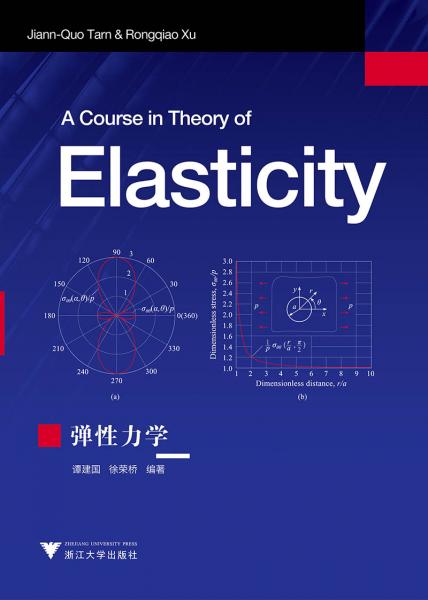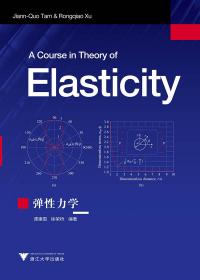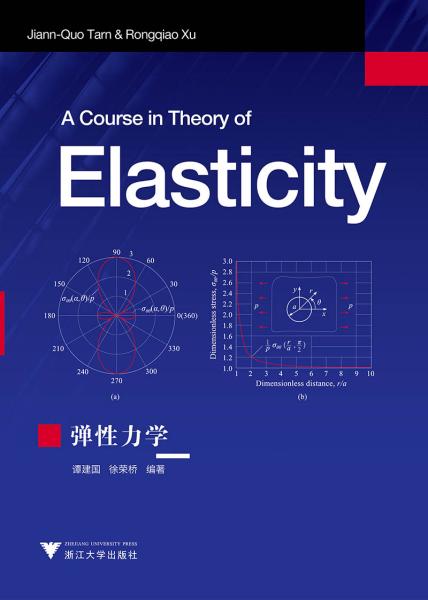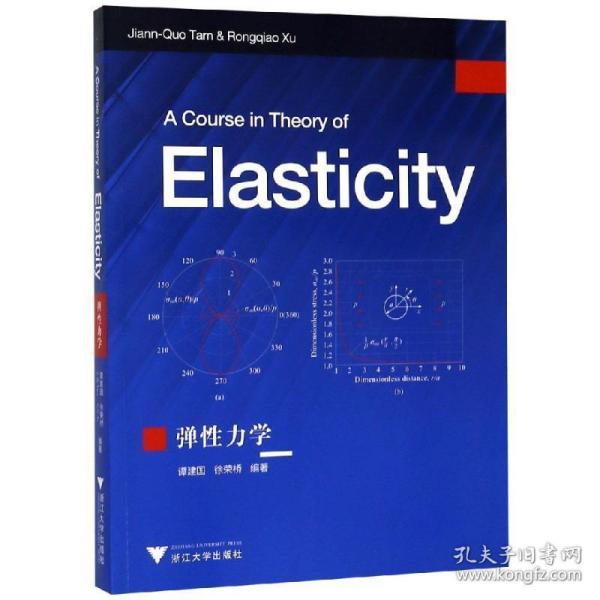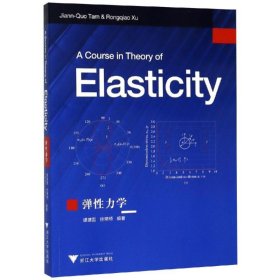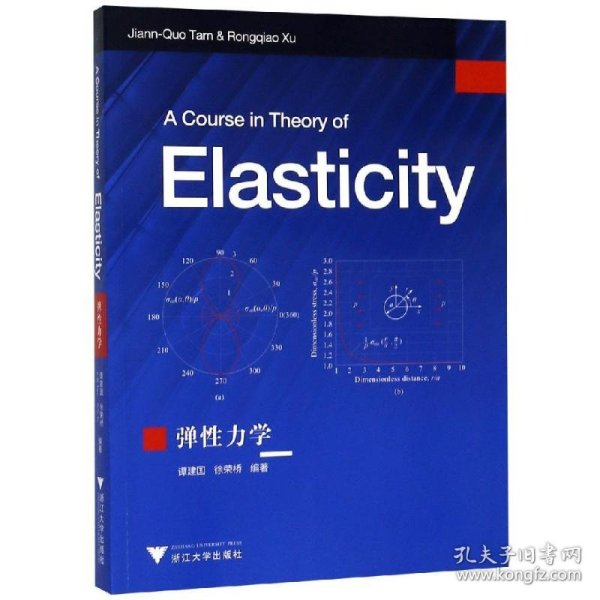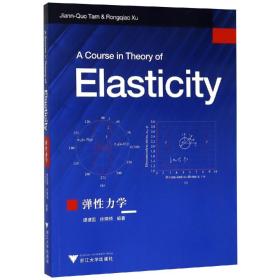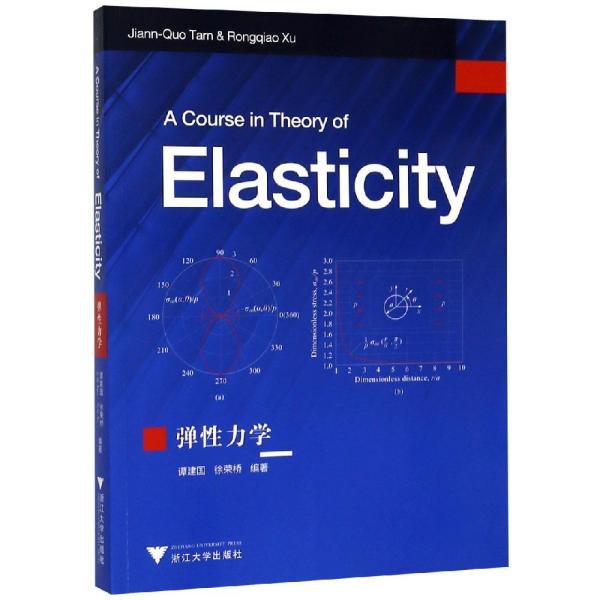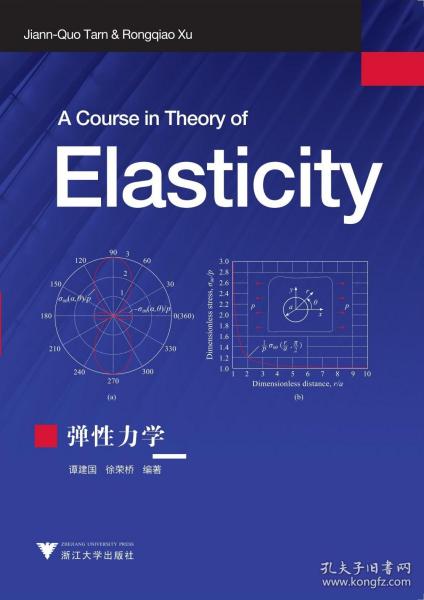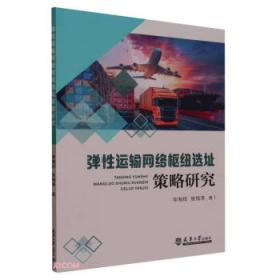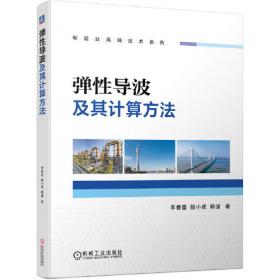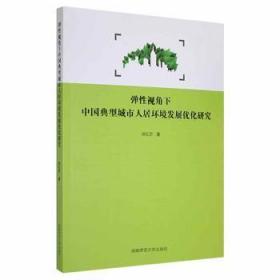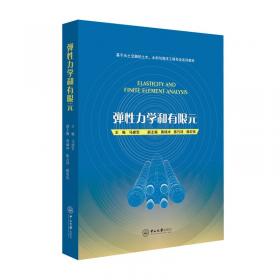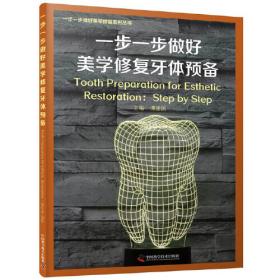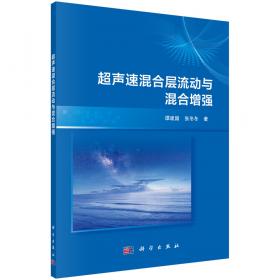弹性力学
出版时间:
2019-07
版次:
1
ISBN:
9787308186681
定价:
68.00
装帧:
平装
开本:
16开
纸张:
胶版纸
页数:
348页
字数:
748千字
3人买过
-
主要内容包括笛卡尔张量、应力理论、应变分析、弹性力学本构关系、弹性力学问题的一般理论、平面问题的直角坐标解法和极坐标解法、柱形杆的扭转和弯曲、空间问题和接触问题、热应力、弹性波的传播、弹性力学问题的复变函数解法、弹性力学问题的变分解法等。
谭建国美国杜克大学(duke univerity)土木工程系博士,台湾成功大学土木工程系讲座教授、浙江大学建筑工程学院土木系客座教授,中科院航发中心应力分析组教授顾问,中国土木水利工程 Chapter 1 Mathematical Prerequisites
1.1 Index Notation
1.1.1 Range convention
1.1.2 Summation convention
1.1.3 The Kronecker delta
1.1.4 The permutation symbol
1.2 Vector Operations and Some Useful Integral Theorems
1.2.1 The scalar product of two vectors
1.2.2 The vector product of two vectors
1.2.3 The scalar triple product
1.2.4 The gradient of a scalar function
1.2.5 The divergence of a vector function
1.2.6 The curl of a vector function
1.2.7 Laplacian of a scalar function
1.2.8 Divergence theorem (Gauss's theorem)
1.2.9 Stokes' theorem
1.2.10 Green's theorem
1.3 Cartesian Tensors and Transformation Laws
Problems 1
Chapter 2 Analysis of Stress
2.1 Continuum
2.2 Forces
2.3 Cauchy's Formula
2.4 Equations of Equilibrium
2.5 Stress as a Second-order Tensor
2.6 Principal Stresses
2.7 Maximum Shears
2.8 Yields Criteria
Problems 2
Chapter 3 Analysis of Strain
3.1 Differential Element Considerations
3.2 Linear Deformation and Strain
3.3 Strain as a Second-order Tensor
3.4 Principal Strains and Strain Measurement
3.5 Compatibility Equations
3.6 Finite Deformation
Problems 3
Chapter 4 Linear Elastic Materials, Framework of Problems of Elasticity
4.1 Introduction
4.2 Uniaxial Stress-Strain Relations of Linear Elastic Materials
4.3 Hooke's Law
4.3.1 Isotropic materials
4.3.2 Orthotropic materials
4.3.3 Transversely isotropic materials
4.4 Generalized Hooke's Law
4.5 Elastic Constants as Components of a Fourth-order Tensor
4.6 Elastic Symmetry
4.6.1 One plane of elastic symmetry (monoclinic material)
4.6.2 Two planes of elastic symmetry
4.6.3 Three planes of elastic symmetry (orthotropic material)
4.6.4 An axis of elastic symmetric (rotational symmetry)
4.6.5 Complete symmetry (spherical symmetry)
4.7 Elastic Moduli
4.7.1 Simple tension
4.7.2 Pure shear
4.7.3 Hydrostatics pressure
4.8 Formulation of Problems of Elasticity
4.9 Principle of Superposition
4.10 Uniqueness of Solution
4.11 Solution Approach
Problems 4
Chapter 5 Some Elementary Problems
5.1 Extension of Prismatic Bars
5.2 A Column under Its Own Weight
5.3 Pure Bending of Beams
5.4 Torsion of a Shaft of Circular Cross Section
Problems 5
Chapter 6 Two-dimensional Problems
6.1 Plane Strain
6.2 Plane Stress
6.3 Connection between Plane Strain and Plane Stress
6.4 Stress Function Formulation
6.5 Plane Problems in Cartesian Coordinates
6.5.1 Polynomial solutions
6.5.2 Product solutions
6.6 Plane Problems in Polar Coordinates
6.6.1 Basic equations in polar coordinates
6.6.2 Stress function in polar coordinates
6.6.3 Problems with axial symmetry
6.6.4 Problems without axial symmetry
6.7 Wedge Problems
6.7.1 A wedge subjected to a couple at the apex
6.7.2 A wedge subjected to concentrated loads at the apex
6.7.3 A wedge subjected to uniform edge loads
6.8 Half-plane Problems
6.9 Crack Problems
Problems 6
Chapter 7 Torsion and Flexure of Prismatic Bars
7.1 Saint-Venant's Problem
7.2 Torsion of Prismatic Bars
7.2.1 Displacement formulation
7.2.2 Stress function formulation
7.2.3 Illustrative examples
7.3 Membrane Analogy
7.4 Torsion of Multiply Connected Bars
7.5 Torsion of Thin-walled Tubes
7.6 Flexure of Beams Subjected to Transverse End Loads
7.6.1 Formulation and solution
7.6.2 Illustrative examples
Problems 7
Chapter 8 Complex Variable Methods
8.1 Summary of Theory of Complex Variables
8.1.1 Complex functions
8.1.2 Some results from theory of analytic functions
8.1.3 Conformal mapping
8.2 Plane Problems of Elasticity
8.2.1 Complex formulation of two-dimensional elasticity
8.2.2 Illustrative examples
8.2.3 Complex representation with conformal mapping
8.2.4 Illustrative examples
8.3 Problems of Saint-Venant's Torsion
8.3.1 Complex formulation with eonformal mapping
8.3.2 Illustrative examples
Problems 8
Chapter 9 Three-dimensional Problems
9.1 Introduction
9.2 Displacement Potential Formulation
9.2.1 Galerkin vector
9.2.2 Papkovich-Neuber functions
9.2.3 Harmonic and biharmonic functions
9.3 Some Basic Three-dimensional Problems
9.3.1 Kelvin's problem
9.3.2 Boussinesq's problem
9.3.3 Cerruti's problem
9.3.4 Mindlin's problem
9.4 Problems in Spherical Coordinates
9.4.1 Hollow sphere under internal and external pressures
9.4.2 Spherical harmonics
9.4.3 Axisymmetric problems of hollow spheres
9.4.4 Extension of an infinite body with a spherical cavity
Problems 9
Chapter 10 Variational Principles of Elasticity and Applications
10.1 Introduction
10.1.1 The shortest distance problem
10.1.2 The body of revolution problem
10.1.3 The hrachistochrone problem (the shortest time problem)
10.2 Variation Operation
10.3 Minimization of Variational Functionals
10.4 Illustrative Examples
10.5 Principle of Virtual Work
10.6 Principle of Minimum Potential Energy
10.7 Principle of Minimum Complementary Energy
10.8 Reciprocal Theorem
10.9 Hamilton's Principle of Elastodynamics
10.10 Vibration of Beams
10.11 Bending and Stretching of Thin Plates
10.12 Equivalent Variational Problems
10.12.1 Self-adjoint ordinary differential equations
10.12.2 Self-adjoint partial differential equations
10.13 Direct Methods of Solution
10.13.1 The Ritz method
10.13.2 The Galerkin method
10.14 Illustrative Examples
10.15 Closing Remarks
Problems 10
Chapter 11 State Space Approach
11.1 Introduction
11.2 Solution of Systems of Linear Differential Equations
11.2.1 Solution of homogeneous system
11.2.2 Solution of nonhomogeneous system
11.3 State Space Formalism of Linear Elasticity
11.3.1 State variable representation of basic equations
11.3.2 Hamiltonian formulation
11.3.3 Explicit state equation and output equation
11.4 Analysis of Stress Decay in Laminates
11.5 Application to Two-dimensional Problems
11.5.1 Infinite-plane Green's function
11.5.2 Half-plane Green's functions
11.5.3 A half-plane under line load
11.5.4 Extension of infinite plate with an elliptical hole
11.6 Symplectic Characteristics of Hamiltonian System
11.6.1 Simpie and semisimple systems
11.6.2 Non-semisimple system
11.7 Application to Three-dimensional Elasticity
Problems 11
References
Appendix A Basic Equations in Cylindrical and Spherical Coordinates
Appendix B Fourier Series
Appendix C Product Solution of Biharmonic Equation in Cartesian Coordinates
Appendix D Product Solution of Biharmonic Equation in Polar Coordinates
Index
-
内容简介:
主要内容包括笛卡尔张量、应力理论、应变分析、弹性力学本构关系、弹性力学问题的一般理论、平面问题的直角坐标解法和极坐标解法、柱形杆的扭转和弯曲、空间问题和接触问题、热应力、弹性波的传播、弹性力学问题的复变函数解法、弹性力学问题的变分解法等。
-
作者简介:
谭建国美国杜克大学(duke univerity)土木工程系博士,台湾成功大学土木工程系讲座教授、浙江大学建筑工程学院土木系客座教授,中科院航发中心应力分析组教授顾问,中国土木水利工程
-
目录:
Chapter 1 Mathematical Prerequisites
1.1 Index Notation
1.1.1 Range convention
1.1.2 Summation convention
1.1.3 The Kronecker delta
1.1.4 The permutation symbol
1.2 Vector Operations and Some Useful Integral Theorems
1.2.1 The scalar product of two vectors
1.2.2 The vector product of two vectors
1.2.3 The scalar triple product
1.2.4 The gradient of a scalar function
1.2.5 The divergence of a vector function
1.2.6 The curl of a vector function
1.2.7 Laplacian of a scalar function
1.2.8 Divergence theorem (Gauss's theorem)
1.2.9 Stokes' theorem
1.2.10 Green's theorem
1.3 Cartesian Tensors and Transformation Laws
Problems 1
Chapter 2 Analysis of Stress
2.1 Continuum
2.2 Forces
2.3 Cauchy's Formula
2.4 Equations of Equilibrium
2.5 Stress as a Second-order Tensor
2.6 Principal Stresses
2.7 Maximum Shears
2.8 Yields Criteria
Problems 2
Chapter 3 Analysis of Strain
3.1 Differential Element Considerations
3.2 Linear Deformation and Strain
3.3 Strain as a Second-order Tensor
3.4 Principal Strains and Strain Measurement
3.5 Compatibility Equations
3.6 Finite Deformation
Problems 3
Chapter 4 Linear Elastic Materials, Framework of Problems of Elasticity
4.1 Introduction
4.2 Uniaxial Stress-Strain Relations of Linear Elastic Materials
4.3 Hooke's Law
4.3.1 Isotropic materials
4.3.2 Orthotropic materials
4.3.3 Transversely isotropic materials
4.4 Generalized Hooke's Law
4.5 Elastic Constants as Components of a Fourth-order Tensor
4.6 Elastic Symmetry
4.6.1 One plane of elastic symmetry (monoclinic material)
4.6.2 Two planes of elastic symmetry
4.6.3 Three planes of elastic symmetry (orthotropic material)
4.6.4 An axis of elastic symmetric (rotational symmetry)
4.6.5 Complete symmetry (spherical symmetry)
4.7 Elastic Moduli
4.7.1 Simple tension
4.7.2 Pure shear
4.7.3 Hydrostatics pressure
4.8 Formulation of Problems of Elasticity
4.9 Principle of Superposition
4.10 Uniqueness of Solution
4.11 Solution Approach
Problems 4
Chapter 5 Some Elementary Problems
5.1 Extension of Prismatic Bars
5.2 A Column under Its Own Weight
5.3 Pure Bending of Beams
5.4 Torsion of a Shaft of Circular Cross Section
Problems 5
Chapter 6 Two-dimensional Problems
6.1 Plane Strain
6.2 Plane Stress
6.3 Connection between Plane Strain and Plane Stress
6.4 Stress Function Formulation
6.5 Plane Problems in Cartesian Coordinates
6.5.1 Polynomial solutions
6.5.2 Product solutions
6.6 Plane Problems in Polar Coordinates
6.6.1 Basic equations in polar coordinates
6.6.2 Stress function in polar coordinates
6.6.3 Problems with axial symmetry
6.6.4 Problems without axial symmetry
6.7 Wedge Problems
6.7.1 A wedge subjected to a couple at the apex
6.7.2 A wedge subjected to concentrated loads at the apex
6.7.3 A wedge subjected to uniform edge loads
6.8 Half-plane Problems
6.9 Crack Problems
Problems 6
Chapter 7 Torsion and Flexure of Prismatic Bars
7.1 Saint-Venant's Problem
7.2 Torsion of Prismatic Bars
7.2.1 Displacement formulation
7.2.2 Stress function formulation
7.2.3 Illustrative examples
7.3 Membrane Analogy
7.4 Torsion of Multiply Connected Bars
7.5 Torsion of Thin-walled Tubes
7.6 Flexure of Beams Subjected to Transverse End Loads
7.6.1 Formulation and solution
7.6.2 Illustrative examples
Problems 7
Chapter 8 Complex Variable Methods
8.1 Summary of Theory of Complex Variables
8.1.1 Complex functions
8.1.2 Some results from theory of analytic functions
8.1.3 Conformal mapping
8.2 Plane Problems of Elasticity
8.2.1 Complex formulation of two-dimensional elasticity
8.2.2 Illustrative examples
8.2.3 Complex representation with conformal mapping
8.2.4 Illustrative examples
8.3 Problems of Saint-Venant's Torsion
8.3.1 Complex formulation with eonformal mapping
8.3.2 Illustrative examples
Problems 8
Chapter 9 Three-dimensional Problems
9.1 Introduction
9.2 Displacement Potential Formulation
9.2.1 Galerkin vector
9.2.2 Papkovich-Neuber functions
9.2.3 Harmonic and biharmonic functions
9.3 Some Basic Three-dimensional Problems
9.3.1 Kelvin's problem
9.3.2 Boussinesq's problem
9.3.3 Cerruti's problem
9.3.4 Mindlin's problem
9.4 Problems in Spherical Coordinates
9.4.1 Hollow sphere under internal and external pressures
9.4.2 Spherical harmonics
9.4.3 Axisymmetric problems of hollow spheres
9.4.4 Extension of an infinite body with a spherical cavity
Problems 9
Chapter 10 Variational Principles of Elasticity and Applications
10.1 Introduction
10.1.1 The shortest distance problem
10.1.2 The body of revolution problem
10.1.3 The hrachistochrone problem (the shortest time problem)
10.2 Variation Operation
10.3 Minimization of Variational Functionals
10.4 Illustrative Examples
10.5 Principle of Virtual Work
10.6 Principle of Minimum Potential Energy
10.7 Principle of Minimum Complementary Energy
10.8 Reciprocal Theorem
10.9 Hamilton's Principle of Elastodynamics
10.10 Vibration of Beams
10.11 Bending and Stretching of Thin Plates
10.12 Equivalent Variational Problems
10.12.1 Self-adjoint ordinary differential equations
10.12.2 Self-adjoint partial differential equations
10.13 Direct Methods of Solution
10.13.1 The Ritz method
10.13.2 The Galerkin method
10.14 Illustrative Examples
10.15 Closing Remarks
Problems 10
Chapter 11 State Space Approach
11.1 Introduction
11.2 Solution of Systems of Linear Differential Equations
11.2.1 Solution of homogeneous system
11.2.2 Solution of nonhomogeneous system
11.3 State Space Formalism of Linear Elasticity
11.3.1 State variable representation of basic equations
11.3.2 Hamiltonian formulation
11.3.3 Explicit state equation and output equation
11.4 Analysis of Stress Decay in Laminates
11.5 Application to Two-dimensional Problems
11.5.1 Infinite-plane Green's function
11.5.2 Half-plane Green's functions
11.5.3 A half-plane under line load
11.5.4 Extension of infinite plate with an elliptical hole
11.6 Symplectic Characteristics of Hamiltonian System
11.6.1 Simpie and semisimple systems
11.6.2 Non-semisimple system
11.7 Application to Three-dimensional Elasticity
Problems 11
References
Appendix A Basic Equations in Cylindrical and Spherical Coordinates
Appendix B Fourier Series
Appendix C Product Solution of Biharmonic Equation in Cartesian Coordinates
Appendix D Product Solution of Biharmonic Equation in Polar Coordinates
Index
查看详情
-
全新
广东省广州市
平均发货18小时
成功完成率95.95%
-
全新
北京市朝阳区
平均发货11小时
成功完成率85.84%
-
全新
广东省广州市
平均发货16小时
成功完成率93.81%
-
全新
广东省广州市
平均发货17小时
成功完成率94.32%
-
全新
广东省广州市
平均发货18小时
成功完成率95.93%
-
全新
广东省广州市
平均发货17小时
成功完成率94.08%
-
全新
四川省成都市
平均发货7小时
成功完成率96.64%
-
全新
江苏省无锡市
平均发货14小时
成功完成率92.5%
-
全新
天津市西青区
平均发货14小时
成功完成率91.73%
-
弹性力学
正版现货,套书只发一本,多版面书籍只对书名
九品
北京市东城区
平均发货17小时
成功完成率91.16%
-
弹性力学
正版现货,套书只发一本,多版面书籍只对书名
九品
北京市海淀区
平均发货17小时
成功完成率91.21%
-
全新
北京市通州区
平均发货15小时
成功完成率79.92%
-
 5
5
全新
北京市丰台区
平均发货27小时
成功完成率82.35%
-
弹性力学
正版现货,品相完整,套书只发一本,多版面书籍只对书名
九五品
河北省廊坊市
平均发货12小时
成功完成率92.86%
-
全新
广东省广州市
平均发货15小时
成功完成率84.63%
-
弹性力学(英文版)
①全新正版,现货速发,7天无理由退换货②天津仓、成都仓、无锡仓、广东仓、武汉仓等多仓就近发货,订单最迟48小时内发出③无法指定快递④可开电子发票,不清楚的请咨询客服。
全新
浙江省嘉兴市
平均发货15小时
成功完成率93.11%
-
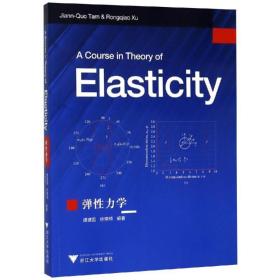 2
2
全新
河北省保定市
平均发货14小时
成功完成率87.56%
-
全新
江苏省南京市
平均发货11小时
成功完成率89.9%
-
全新
江苏省南京市
平均发货14小时
成功完成率84.36%
-
全新
北京市东城区
平均发货9小时
成功完成率96.33%
-
全新
天津市河东区
平均发货19小时
成功完成率93.65%
-
全新
北京市通州区
平均发货9小时
成功完成率94.09%
-
弹性力学
大中专文科文教综合 新华书店全新正版书籍
全新
江苏省无锡市
平均发货7小时
成功完成率96.31%
-
全新
广东省广州市
平均发货7小时
成功完成率94.16%
-
全新
浙江省嘉兴市
平均发货9小时
成功完成率92.38%
-
全新
北京市西城区
平均发货19小时
成功完成率92.42%
-
九五品
天津市武清区
平均发货25小时
成功完成率82.77%
-
九五品
浙江省杭州市
平均发货24小时
成功完成率82.59%
-
九五品
北京市通州区
平均发货26小时
成功完成率82.58%
-
全新
四川省成都市
平均发货13小时
成功完成率80.68%
-
弹性力学
正版现货,套书只发一本,多版面书籍只对书名
九品
北京市海淀区
平均发货16小时
成功完成率87.43%
-
弹性力学/谭建国
全新正版,极速发货,以书名及ISBN为准下单发货,图片仅供参考不作为下单发货依据
全新
重庆市綦江区
平均发货19小时
成功完成率73.5%
-
八品
浙江省杭州市
平均发货8小时
成功完成率91.54%
-
全新
江西省抚州市
平均发货20小时
成功完成率78.67%
-
全新
北京市朝阳区
平均发货13小时
成功完成率93.26%
-
全新
北京市朝阳区
平均发货13小时
成功完成率93.26%
-
全新
四川省成都市
平均发货15小时
成功完成率85.71%
-
九五品
北京市昌平区
平均发货13小时
成功完成率85.35%
-
 6
6
九品
河南省郑州市
平均发货9小时
成功完成率96.11%
-
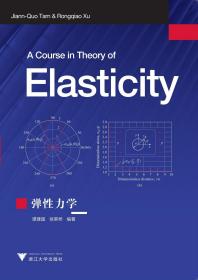 5
5
全新
浙江省杭州市
平均发货24小时
成功完成率86.84%
-
九五品
北京市海淀区
平均发货3小时
成功完成率98.11%
-
全新
广东省广州市
平均发货8小时
成功完成率83.73%
-
2024年 印刷
印次: 1
九五品
-
九五品

 占位居中
占位居中

